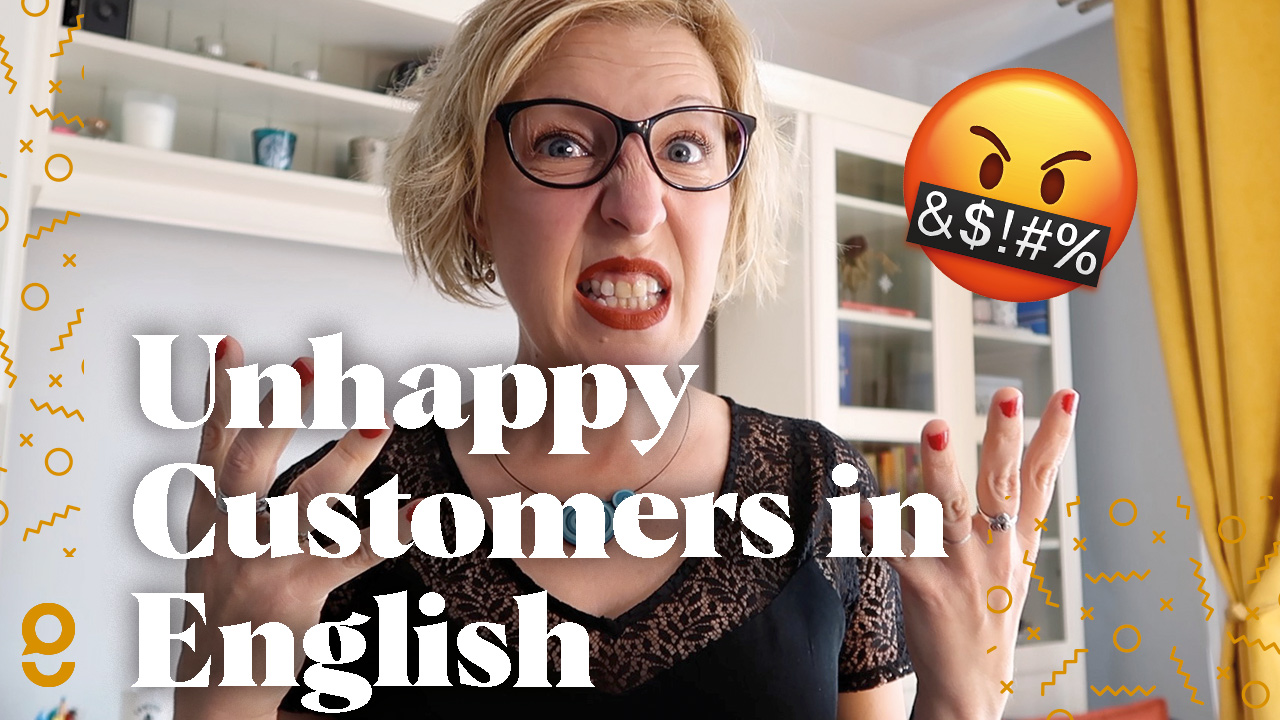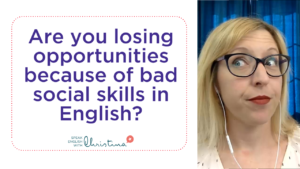
Unhappy customers! They can be challenging to deal with even in your native language. And if you’re managing your customers in English, that can make your job even harder.
Even if you have a lot of experience in business, I’ve found that many of my clients can use a little help being more diplomatic in these situations. Why?
There are two reasons:
First of all, if you’re not 100% comfortable with your English–and you’re in a stressful situation, you’re likely to fall back to a way of speaking that is not very advanced.
And most of the time: If you use the English you learned in school in a delicate situation, you’re probably being too direct.
So at the end of today’s lesson, I’ll have some expressions to help you sound more diplomatic (and more advanced).
But there’s another reason my clients are sometimes too direct in delicate situations like dealing with unhappy customers.
English-speakers have different expectations from their business contacts. It’s important to understand the culture too. And English speakers might have different expectations about what will happen when there’s an unhappy customer.
Today we’ll talk about all of that and you’ll learn how to handle unhappy customers like a pro–in English.
Index:
1. Dealing with unhappy customers in English: First, understand the culture and your customer’s expectations.
2. Dealing with unhappy customers in English: Are you using the right body language?
3. Dealing with unhappy customers in English: Use language that shows you’re listening.
4. Dealing with unhappy customers in English: Don’t be afraid to apologize.
5. Dealing with unhappy customers in English: Focus on Solution
1. Dealing with unhappy customers in English: First, understand the culture and your customer’s expectations.
I’m originally from the States and one of the first things I notice on trips home is the difference between customer service in France and in the US.
In the States literally everyone has heard the expression: “The customer is king.”
And we will go out of our way to be professional–and diplomatic when a customer or client is unhappy.
It might seem a little strange to you to have to change your way of doing business to work with people from other cultures and backgrounds. But maybe it’s a good problem to have!
It means we can do business with people from all over the globe.
As I run my own business with international clients, I’ve realized something: we’re stronger together.
Let’s work on handling those unhappy customers in a way that fits their cultural expectations. We’ll do this together–so you can be stronger in business.
Also check out my lesson: Learning English with no Social Skills?
2. Dealing with unhappy customers in English: Are you using the right body language?
A really interesting thing we do when dealing with difficult or unhappy customers in the US is not even in English!
We start with body language: the way we speak and communicate with our bodies and the way we hold ourselves.
The good news for you is that you don’t have to memorize expressions to have the right body language!
Body Language: what NOT to do.
Let’s start with how NOT to hold your body while you deal with an unhappy customer.
To see what this actually looks like, be sure to check out the video.
- Don’t stand with your arms crossed.
- Don’t point your finger at your customer.
- Don’t stand with your hands on your hips.
Using this kind of body language can make you seem defensive, or like you’re not willing to listen. Or it can even look negative or aggressive.
Body Language: do this instead.
To look like you’re listening and interested in finding solutions, try this:
- Face the person you’re speaking with and even lean slightly forward.
- Smile. I know some people who keep a smile on their face even on the phone with unhappy customers–it helps you stay more diplomatic!
- Nod your head–like you’re saying “Yes.”
All of these gestures show that you are listening and trying to help.
Also check out my lesson: How to deal with rude coworkers.
3. Dealing with unhappy customers in English: Use language that shows you’re listening.
As you probably already know, showing someone that you are listening can help move a difficult situation forward.
And it’s easy to do this in English.
Here are some expressions that will help you sound diplomatic and show that you are listening and that you understand your customer.
“I see what you mean.”
“I see what you’re saying.”
“I hear what you are saying”
“I really do understand your frustration.”
Another great way to show you understand is by rephrasing. This works even if you realize you can’t agree with your customer.
Try using one of these expressions:
“I understand that you are not satisfied with…”
“I understand you are not happy with…”
For example, you might say:
“I understand you’re not satisfied with the service you received.”
4. Dealing with unhappy customers in English: Don’t be afraid to apologize.
When we are in business long enough, there will be occasions to apologize. Missed deadlines, commitments that our companies could not meet. Human error!
Here’s how to apologize with style in English:
“I’m sorry that…”
For example: “I’m sorry that we did not meet your deadline.”
“Please accept our apologies…”
For example: “Please accept our apologies for any convenience caused.”
5. Dealing with unhappy customers in English: Focus on Solutions
Your English-speaking client will probably be expecting you to suggest solutions. And that’s probably what you would want to offer as well.
So let’s look at some ways you can offer solutions.
Of course, you’re going to want to take care of your customer’s problem.
For some problems you can offer one of the following:
- a discount–so your client pays less for a service or product.
- a refund–when you give your client all his or her money back.
- a voucher–an agreement or certificate your client can use for free services or products in the future.
- a replacement–when you send a new part, or product in place of a (defective or unavailable one).
In this case, you might say something like:
“I can offer you a discount for the items you received late.”
Or
“We’re really sorry about the technical issues on our website–we’d like to offer your company a refund for this month’s service agreement.”
When the problem is a little more…complicated.
If the problem is a complex one, you’ll still want to show that you’re going to try to solve it.
Here’s is one way you might go about showing you’re solving your client’s problem when it’s more complex:
“I know you need ______,
So I will try to _____
If I can’t do that, I’ll__________”
So, for example, you might say:
“I know you need the results of our research by next month.
So I will try to see if we can speed up the process by moving more of our team members onto this project.
If I can’t do that, I’ll see if we can collaborate with another laboratory.”
Dealing with unhappy customers in English: It’s so much better when you’re prepared!
Now you know what your English-speaking clients and customers are expecting when they come to you with a problem. You also have an idea of what kind of body language to use. And what to say–in English.
So you can help your customers with their problems in English too. Even if they come from other cultures and countries.
Like I said in the beginning of this lesson: We’re better together.
We’re better when we can do business with all kinds of people.
We’re better when we make the effort to try new ways of communicating.
And when we learn new ways of working–in English–together.
Also check out my lesson: Negotiations in English.
Take the next step: Improve your English in the comments
The best way to become more confident using Business English is to practice!
Here’s your Confidence Challenge for this week:
1. Think of a situation where you might have to deal with an unhappy customer.
2. Write a phrase you might be likely to use in that situation in the comments.
If you learned something from this lesson, please share it with your coworkers & friends. You can send your message to them in English for more practice!
Click here to share this article on LinkedIn
Click here to share this article on Facebook
Become more fluent & comfortable in conversations
If you would like to take the next step with me, discover my Faster Fluency Conversation Club Membership Program!
It helps you become more confident speaking in conversations, and get a lot more vocabulary on many different topics! And it’s a fabulous community of “English buddies” from around the world!
TIP: Use the code FFCC40 to save -40% off your 1st month of membership!
More details at https://christinarebuffetcourses.com/faster-fluency-conversation-club/join-now
Can’t wait to see you in the Club,
Christina
More good stuff…
Click the image to learn more







